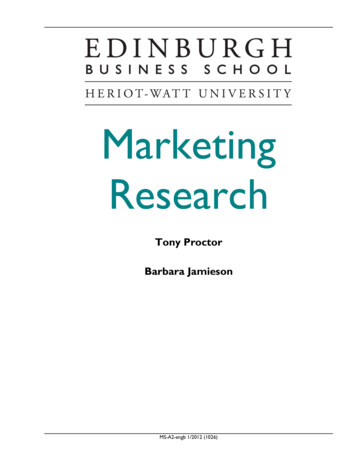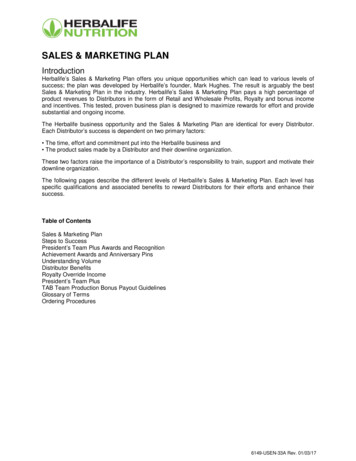
Transcription
Mothercare Marketing Plan
TABLE OF CONTENTSExecutive Summary . . . 1Section 1: Introduction . . . 21.1 The Company . . . 21.2 The Innovative Business Idea . . . .2Section 2: The SOSTAC Planning Framework . . 3Section 3: First Stage: Situational Analysis . . 43.1 External marketing Audit . 43.2 Internal Marketing Audit . . 63.3 SWOT Analysis . 9Section 4: Second Stage: Objectives . . 104.1 Mission Statement . 104.2 Objectives . 10Section 5: Third Stage: Strategy . . 115.1 Mothercare’s Present Strategy . 115.3 Mothercare 360 Campaign: The Proposed Strategy . 125.3 Application of Ansoff Matrix . 125.4 The STP Process . 13Section 6: Fourth Stage: Tactics . 156.1 The Marketing Mix . . . 15Section 7: Fifth Stage: Action Plan . 18Section 8: Sixth Stage: Control and Implementation . 208.1 Balanced Scorecard Approach . . 208.2 Operational Strategy and Issues . 228.3 Integration of Marketing and Operations . 248.4 Risk Assessment and Recommendations . 268.41 Maintenance of a Healthy and Safe Environment . 27Section 9: Conclusion . . 292
Appendices . 30References . . 353
EXECUTIVE SUMMARYIn the 21st century, women have become more health conscious and are continuously finding ways tolook smart, trendy, slim and maintain their figure. However, most women who are expecting a childor who already have children have difficulty in maintaining the same beautiful shape they once had.The specialist brand retailer, Mothercare, has been around for more than 40 years and has alwaysdelivered on its promise of caring for women every step of the way. Now Mothercare wants to keepits binding promise and lend a helping hand. The senior management had assigned a marketing andoperations team to develop the ‘Mothercare 360 Campaign’ for keeping women of all ages in tip topshape by offering them the best professional advice and care available at the new Mothercarewomen’s gym, opening in April 2011.The project report for delivering the Mothercare 360 Campaign has the following nine sections: Section 1 gives a brief introduction to Mothercare Plc. Section 2 gives a brief description of the SOSTAC model which is divided into six stages andwill be applied in this project report to create an effective marketing campaign. Section 3 presents an environmental analysis using PEST, Porter’s five forces and SWOTmodels. Section 4 defines the marketing objectives of the campaign. Section 5 defines the marketing strategy of the campaign which will accomplish the setobjectives. Section 6 defines the marketing tactics in the form of the Marketing Mix. Section 7 gives a detailed outline of the action plan to be achieved using a Gantt chart and abudget analysis. Section 8 discusses the control and implementation phase, contingency planning, integration ofmarketing and operations and risk assessment. Section 9 concludes this project report.1
SECTION 1INTRODUCTION1.1 THE COMPANYFounded in 1961, Mothercare is a specialist retailer of parenting and children’s products. Thecompany offers maternity and children’s clothing, furniture and home furnishings, bedding,feeding-, bathing- and travel equipment and toys (Datamonitor 2010).Mothercare has more than a 1000 stores across the globe. The company recorded a substantialincrease in revenue; 723.6 million in the financial year ending March 2009 and worldwidenetwork sales up to 1.1 billion by April 2010 (Datamonitor 2010). Appendix A gives aconsolidated view of Mothercare’s financial statements.Headquartered in the United Kingdom, where Mothercare displayed weaker sales in first quarter of2010, the company has expanded its operations in Europe, Middle East, Africa and the Far East.Mothercare’s major competitors include Jacques Vert, the Marks and Spencer Group, Monsoon,Moss Bros Group, NEXT, Alexon Group PLC and Toys R Us LimitedIan PeacockChairman, Mothercare PlcSource: Mothercare (2010) and (Datamonitor 2010).1.2 THE INOVATIVE BUSINESS IDEA‘The Expansion of the Mothercare Group into the UK’s Health and Fitnessindustry by opening a new gym for women of all ages’2
SECTION 2THE SOSTAC PLANNING FRAMEWORKBusinesses typically either thrive in their market or simply fail. The difference between a businessthat thrives and one that fails is often the marketing plan that is created and used (Chaffey et al.,2005). Though various marketing plans have proven effective over the years, many experiencedbusiness consultants claim that the SOSTAC model is one of the most effective (Smith and Taylor2004).Created by Paul Russell Smith, the SOSTAC planning framework is one of the most powerfulplanning systems ever developed. It is extremely effective as it contains the six vital ingredientsfor the perfect marketing plan (Fig. 2).Fig.2PR SMITH’S SOSTAC PLANNING FRAMEWORKSSITUATIONAL ANALYSISOOBJECTIVESSSTRATEGYTWhere are we now?STAGE 1Where do we want to go?STAGE 2How do we get there?STAGE 3TACTICSWhat tools do we use to implementthe strategy?STAGE 4AACTION PLANDetailed Action Plan for each tooland tactic.STAGE 5CCONTROLTracking our progress by measuring,monitoring,reviewing, modifying and updatingSTAGE 6Source : Smith (2003)3
SECTION 3FIRST STAGE: SITUATIONAL ANALYSISIf an organisation wants to expand into a different type of industry or business setting, it is of vitalimportance for the organisation to conduct a situational analysis in order to keep up with thechanging environmental trends and to strengthen the foundation of their strategies (IDM Firm2007).A Situational or Environmental Analysis can be defined as a problem-definition frameworkdesigned for the systematic collection of past and present data to examine the trends, forces,internal factors and external factors which have a potential to influence the performance of thebusiness (AMA 2007).The first stage of the SOSTAC planning framework, Situational Analysis is undertaken by theapplication of PEST Analysis, Porter’s Five Forces and SWOT Analysis.3.1 EXTERNAL MARKETING AUDITTo examine Mothercare’s external market, the macro-environmental model called the PESTanalysis was used to study the political, economic, social factors and the technological climate.Figure 3.0 gives an illustration of Mothercare’s external environment using the PEST model.4
Figure 3.0PEST ANALYSIS OF MOTHERCARE (EXTERNAL)ECONOMICPOLITICAL General ElectionsThe political importance of parents with babies andyoung children is underlined by the ‘Mumsnetelection’ in May 2010. Ethical Trading and SuppliersMothercare sources products from around theworld and has a code of practice on the EthicalTrading Initiative’s Base Code. All suppliers shareits values and are committed to working towardscompliance with its Code. Environmental policyMothercare is fully committed to protecting itscustomers, people making its products and theenvironment by ensuring efficient use of rawmaterials, optimising the use of energy,encouraging recycling and sustainability, andengaging business partners and stakeholder groups. Corporate Social ResponsibilityThe European government has refused to takeaction on a controversial chemical (BPA), widelyused in babies’ bottles, which could lead to serioushealth issues. Mothercare will be stopping itssupply of older bottles this August.TECHNOLOGICAL Internet Shopping ConvenienceMothercare offers their consumers to shop andhave their goods delivered home using informationtechnology Social Networking WebsitesThe Mothercare group has appointed Diffusionwith developing a social media strategy to targetparents online and offline. The company is also onFacebook and Twitter where B2C interaction ishigh and the company can hear what customershave to say about their products and services.21st Century RetailerUse of laser scanners at cash tills and energyefficient products suited for the modern user. Sources : Mcare (2010), Keynote (2009), Taylor (2010),BBC News (2010), BBC News 2 (2010), BBC News 3(2010), International (2010), BBC News 4 (2010), BBCNews 5 (2010), National Statistics Office (2010), Expat(2009) UK Economic GrowthThe UK economy grew by a faster-than-expected 1.1%in the second quarter of 2010. The UK economy hascome out of recession, after figures showed it hadgrown by a weaker-than-expected 0.1% in the last threemonths of 2009. UK Inflation Rate and IndexesUK inflation slowed for a second consecutive month inJune, to 3.2% from 3.4% in May. The Retail PricesIndex (RPI) inflation measure also fell to 5% from5.1% in May Unemployment RateThe number of people employed increased by 184,000.The number of people unemployed in the UK fell by49,000 to 2.46 million in the three months to June2010. International EconomiesMothercare's overseas franchise business currentlyoperates through 358 stores in 45 countries, primarilyin Europe, the Middle East and the Far East.SOCIAL Marketing Baby ProductsMany social and demographic factors have a stronginfluence on the market for baby products. Theseinclude: falling birth rates, smaller family sizes and theuse of efficient mobility products for longer journeys. UK DemographicsThe UK population grew to 61.8 million in 2010. Therewere 791,000 babies born in 2008, an increase of33,000 on 2007. By 2034, 23 per cent of the populationis projected to be aged 65 and over. UK Firms and CharitiesFirms such as Pearson, Serco and Tribal line up to runfree schools. Mothercare’s principle vehicle fordonations and charity is the Mothercare GroupFoundation UK Living CostsThe cost of living differs depending the person’slifestyle and location. Some provinces and countrysideareas can offer cheap and very affordable livingconditions. London is one of the global commercialand business centres. Living in this major city isdefinitely expensive when compared with smallertowns in the United Kingdom5
3.2 INTERNAL MARKETING AUDITThe IIA and CIPFA maintain that an internal audit of an organisation has an independent assurancefunction and consulting activity which is designed to add value and improve an organisation’soperations. It helps an organisation to accomplish its objectives by examining, evaluating andreporting, and bringing a systematic, disciplined approach to improving the effectiveness of riskmanagement, economic control and the effective use of resources (CIPFA and IIA 2007).For conducting an extensive internal marketing audit, the use of the 6Ms model – men, machinery,money, minutes, material and markets – could be used, but for the purpose of this project report,the internal market of Mothercare will be examined by using Porter’s five forces model.The Porter’s five forces model was developed by Professor Michael Porter in 1980. His frameworkfor industry analysis and business strategy development is a micro-environmental model which isused for identifying an organisation’s competitiveness helping firms to increase their potential bybeing aware of its competitors (Sloman and Sutcliffe 2004).In simple terms, the Porter’s model is a powerful tool for understanding where power lies in abusiness situation. This is useful because it helps one to understand both the strengths of thecurrent competitive position and the strengths of a position one is looking to move into (Mindtools 2007).6
Fig. 3.1MICRO-ECONOMIC APPLICATION OF PORTER’S 5FORCES MODEL TO MOTHERCARE (INTERNAL)ForceIssuesMothercare faces intensecompetition from nine maincompetitors, as listed below.Competitive RivalryImpact on Mothercare GymNegative, as the introduction ofthe Mothercare gym willincrease competition in themarket.Jacques VertMarks and Spencer GroupMonsoonMoss Bros GroupNEXTSeven Arts PicturesAlexon Group PLCHamleys of LondonToys R Us LimitedMothercare faces severecompetition on the price andquality of its products from theabove competitors.Positive, as Mothercare willneed to try harder to attract andretain customers but will offeran additional service not beingoffered by its majorcompetitors.Opening a gym involves highcapital requirements.Negative, as Mothercare needsto invest a lot of capital to startthe new venture.Opening a gym involves a verysubstantial financial investmentfor Mothercare.Negative, as Mothercare needsto invest a lot of financialinvestment to start the newventure.Threat of New EntryThreat of SubstitutionThere are high switching costs ascustomers have a great variety tochoose fromConsumer awareness of price andprovision of quality of productand services.Negative, as Mothercare willneed to continuously monitor itsproduct and service rangeNegative, as high consumerawareness increasesMothercare’s competitivenessand it will always have toprovide the best products andi7
ContinuedThere are large switching costs as buyerswill only buy the best products andservice that satisfies their need.Buyer PowerBargaining power of buyers is high dueto its well-known reputation and positionin the UK market.Mothercare will need to purchase a widerange of goods from suppliers to open upthe gymnasium, eg. gym equipment; alsoproducing marketing materials.Negative, as Mothercare willneed to provide customers withsomething innovative anddifferent that satisfies customersneeds better than itscompetitors.Positive. Buyers will conduct amarket survey and then decidewhich they feel is the bestchoice to satisfy their needs.Positive, as Mothercare willneed to negotiate prices withnew suppliers. This willincrease its supplier base.Supplier PowerHigh supplier power due to strong brandimage and position in the marketPositive, as Mothercare willneed to purchase goods fromsuppliers who provide quality atreasonable prices. Manysuppliers will wish to supply toMothercare due to its strongmarket presence.Refer (Appendix B) for a detailed illustration of Porter’s FrameworkSource : Keynote (2009)8
3.3 SWOT ANALYSISAfter a study of the external (macro) and internal (micro) factors was undertaken, a SWOTanalysis (Figure 3.2) was conducted to assess Mothercare’s current situation. The graphicalframework of SWOT was used to analyse Mothercare’s environment, which aided in the processof determining its major weaknesses (internal), threats (external) and opportunities (external) andconverting them into its major strengths (external).Figure 3.2SWOT ANALYSIS OF MOTHERCARESTRENGTHS (Internal) Establishedbrandposition(40-yearsexperience) Baby products / clothing : specialityretailer Ability to adapt itself to the needs of itsWEAKNESSES (Internal) No product diversity The cost of commission payment to sponsorsand affinity groups. Not targeting the teenage market Fall in sales due to recessioncustomers in international markets Wide variety of products and servicesOPPORTUNITIES (External) Increased sales through an expansion of theservice offerings.THREATS (External) Direct insurance. Fierce competition Decreasing market share The stagnation in affinity group membership Increasing credit options for products. Many customers buy from affinity groups. Can enter a new market (Diversification) Increased sales through Tesco’s websiteThis is a helpful model which will aid in the formulation of Mothercare’s SMART marketingobjectives in Section 4.9
SECTION 4SECOND STAGE: OBJECTIVES4.1 MISSION STATEMENT‘To become the world’s specialist retailer in meeting the needs and aspirations of parentsfor their children’.(Mothercare Plc 2010)4.2 OBJECTIVESFor June 2010 – April 2011, the SMART objectives approved for Mothercare 360 Campaign can besimplified as: To unveil the grand opening of a new Mothercare gymnasium on Mother’s Day (3 April2011) in London, for women of all ages. The specialty gym’s core service will bedelivering the best group or one-to-one programmes that pregnant and post-term womencould ever have. To support the launch of the new gym by generating 50% awareness in the immediatecommunity three weeks before opening. To create special marketing offers by presenting gift vouchers to new gym members. Thesewill be used in the future for comparison and measuring voucher usage at different pointsin time. To measure the campaign’s performance and progress by using electronic awarenessmethods such as point clicking systems on social networking websites and Mothercare’scorporate website.10
SECTION 5THIRD STAGE: STRATEGY5.1 Mothercare’s Present StrategyMothercare has four key growth channels through which they develop their iconic brands. These areas follows:(a) UK retailingMothercare expects its retailing outlets property strategy to deliver 16.1 million of annual benefitseach year by the end of 2012. It has planned to do this by opening more out-of-town parentingcentres, rationalising High Street chains for cutting down costs and targeting certain favourable intown areas as golden opportunities (MSR 2010).(b) DirectDirect has continued its rapid growth with total sales of 126.8 million in the year, an increase of18.2%. The development of e-commerce in the UK over the last ten years has transformed the faceof UK retailing and Mothercare has been in the vanguard of that transformation. Mothercare UK'sDirect business is now over 20% of its UK business, split between orders placed online at home andonline in store (MSR 2010).(c) WholesaleWholesale is currently small, but represents a significant growth opportunity both in the UK andglobally. In the UK, wholesale sales were 4.8 million, an increase of 78%, and this will be boostedin 2010/11 by the autumn launch of Mothercare’s clothing partnership with Boots (MSR 2010).(d) International franchiseMothercare earns profits from its royalties as a fixed percentage of international retail sales. Itsstrategy is to form joint ventures with franchise partners where substantial growth is expected.Mothercare plans to enter new countries, open larger format stores and open at least 100 additionaloverseas stores per year for the foreseeable future (MSR 2010).11
5.2 Mothercare 360 Campaign: The Proposed StrategyIt is very clear from Mothercare’s present strategy that the organisation believes expansion andfurther growth in the same market to be its strategic route to success.5.3 Application of the Ansoff MatrixThe Ansoff Matrix was developed by Igor Ansoff and is a tool to help businesses decide theirproduct and market growth strategy. According to the proposed strategy, Mothercare will be enteringa new market with a new service offering, which in terms of the Ansoff Matrix will be Product /Service Diversification.None of Mothercare’s major competitors have entered the health and fitness market yet. In addition,over the last 40 years Mothercare has had an excellent reputation amongst women who have someconnection with children, are expecting a baby or are mothers. Very few gyms in the UK have hadsuch a long attachment with their customers.The core and unique selling point would be to attract mothers by taking care of them at every stageof the programme which aims to get them into shape or make their pregnancy a memorableexperience. The brand will speak for itself by having an emotional and symbolic impact on otherwomen who will feel that the brand does care for them. Very few gyms in Europe conduct openpregnancy–post pregnancy sessions, thereby giving Mothercare an exceptional advantage over itspresent and potential competitors.Figure 4.0 gives an illustration of the strategic thrust concepts being applied, by using the AnsoffMatrix to define the future direction of Mothercare’s business operations.12
Figure 4.0THE ANSOFF MATRIX FOR MOTHERCAREEXISTINGNEWEXISTINGMARKET PENETRATION(Present Strategy)PRODUCT DEVELOPMENT(Present Strategy)NEWMARKET DEVELOPMENTDIVERSIFICATION(Mothercare 360 Campaign: NewStrategy)Note: With time, when Mothercare enters into the health and fitness market, it will follow asequential four stage process, namely, Build, Hold, Harvest and Digest. The health and fitnessmarket has already gone through all these processes.5.4 THE STP PROCESSSTP stands for:(a) Segmentation – how to divide up the market(s).(b) Targeting – which segments of the market to focus upon.(c) Positioning – how to be perceived in each different target segment.The segmentation, targeting and positioning process of the Mothercare 360 Campaign is illustratedin Figure 5.0.Figure 5.0THE STP PROCESS FOR MOTHERCARE13
SEGMENTATIONMothercare GymThe gym has beendeveloped solely forwomen giving them thefreedom, space andprivacy to exercise withcomplete confidence.Segmented Market byWomen’s StatusTARGETINGPOSITIONINGTargeting By1. Pregnant Women(a) Sex - Females(b) Geography – Central LondonFocus and core target willbe (1) Pregnant Womenwho will be offered thegym’s professional servicesof a one-to-one or groupsessions and uniqueexercises fit for theindividual to perform,depending upon thepregnancy case.1 Pregnant Women2 Post-Pregnant Women3 Non-Pregnant WomenThis target market will beattracted by using:High Priced Package ( 61 permonth) plus discounts asindicated. The high price has beenkept high to the location andbecause Mothercare will be oneof the very few gyms in CentralLondon offering such exceptionalservices.2. Post Pregnant and 3. NonPregnant WomenMedium Priced Package ( 41 permonth) plus discounts asdiscussed(a) 15% Discount vouchers onall mothercare products(b) An additional 5% discountvoucher when getting a newmember (MGM: Member getMember scheme)(c) Special 5% discount ongym membership whenregistering online and aspecial gift.Charity and CSR 1 donated to the MothercareFoundation Charity to help poorchildren around the world.14
SECTION 6FOURTH STAGE: TACTICS6.1 THE MARKETING MIXThe elements of the 6Ps, to be used for Mothercare’s new marketing strategy selection are asfollows:-Product / ServiceThere will be two product developments here. Firstly, as stated in sections 1 and 4, the proposedstrategy recommended in the Mothercare 360 Campaign is for the organisation to take its first stepinto a new market; the health and fitness market. The goal is to offer an exceptional service topregnant, post pregnant women or to women who want to get in shape by opening a newgymnasium.Secondly, the development of a new linking website catering to the needs of consumers and thuscreating a culture of social interactions, chat forums, thread-based culture and consumer-perceptionviewer to study customers at a closer level. Here, using a point-clicking system, Mothercare will beable to get consumer traffic visit responses.PlaceIn the health and fitness sector, the majority of consumers which Mothercare will target willbe those starting as new entries. So the first Mothercare gymnasium’s unveiling will be inCentral London which is the most densely populated city in the UK with more than 7.5million residents (True Knowledge 2010).PriceThe price factor is very important. Psychological pricing shall be applied here,attracting customers and brand switchers to become a part of the brand. As shown inFig. 5.0, the prices of 41 and 61 are purposely kept to make consumers question theextra pound. The 1 will be donated to charity.15
This will become a part of Mothercare’s CSR (Corporate Social Responsibility)approach representing a sense of goodwill and giving something back to thecommunity. Appendix C gives an illustration of Mothercare’s present CSRapproaches.PromotionFour channels of promotions will be used by Mothercare to promote the launch anddelivery of its services:(a) NHS strategic alliance and promotion leaflets. The best way would be for a generalpractitioner to refer pregnant women and patients needing to lose weight directlyto Mothercare;(b) Website promotions;(c) Voucher and gift promotions (one Mothercare gift from a selection);(d) MGM : Member-get-member scheme promotion;(e) Billboard promotions;(f) Television advertisement promotion;(g) Press releases and invitations for the unveiling;(h) Promotional booklets for pregnant women on how they need to take care ofthemselves when exercising, what targets they need to achieve, how to practice ofbreathing techniques with their partners, etc.PeopleHere, an element of relationship marketing through chat forums, social interactions, theawareness-interest-desire factor and the use of special discounts (Figure 5.0) will be used tocreate a sense of appeal for promoting Mothercare’s newly developed image.16
The day for the inauguration of the new gymnasium will be 3 August 2011, a date kept for areason. This is Mothers Day in the UK, a time when children pay respect to and present theirmothers with gifts. The innovative idea behind this is to create a positive psychologicalassociation in the minds of consumers when they think about Mothercare. It should beperceived as an organisation that is providing the best possible care for a mother, startingfrom a historic day which holds a symbolic and cultural representation of a mother’s love,care and tenderness.Physical EvidenceA new gym building will be developed and unveiled by the CEO of Mothercare to provide aplace where women of all ages can have the best gym equipment and staff expertise at theirdisposal.17
SECTION 7FIFTH STAGE: ACTION PLANA budget analysis on how costs will be spread throughout the campaign is presented in Figure 6.0. Atotal of 10.17 million has been approved for the campaign.Figure 6.0BUDGET ANALYSIS: MOTHERCARE 360 CAMPAIGN(1) Television: 2.0 million(2) Billboard: Advertisement place in densely traffic areas 1.0 million x 4 months(3) A4 Leaflets: 20,000* 83p 240(4) Press Release: 8 Days * 845 (600 words with picture) 6,760(5) The Internet (Website) : Point Click System 0(6) Promotional Booklets: Approx. 60 pages * 10* 1000 copies 600,000(7) Gym Building Equipment and Professional Staff: - 6.5 million-------------------------------Total 10.17 million--------------------------------Notes :(a) Staff should be able to deal with extreme situations, e.g., women going into labour.(b) All prices have been deduced thorough market research around the Central Londonarea and Yorkshire region, thereby getting the best prices at supreme quality in order todeliver an efficient campaign.18
19A Gantt Chart for representing the schedule and timescale planning of tactics and strategies used for the Mothercare 360 Campaign are presented in Figure6.1.19
SECTION 8SIXTH STAGE: CONTROL AND IMPLEMENTATIONIn the control phase, whatever was planned will be tallied and compared with actual results. Ganttcharts, performance monitoring systems, statistical measurements and internet traffic monitoringsystems are good ways to measure results.Mothercare should regard measurements (testing effects) towards advertising and databases of vitalimportance. These will act as forecasting tools to let Mothercare know whether the extent ofadvertising or targeting a certain segment should be increased, decreased or kept stable.Contingency Planning is also an important tool which can come in very handy for Mothercare whenit faces tight situations and unexpected results. This is because the Insurance market is unpredictableand which depends on many factors such as taxes, inflation, house prices, etc. It is impossible topredict them. The element of contingency planning will be used where different strategies have to beimplemented due to variations in market factors, e.g. change of price packages through negotiation,dividing the gym into males and females in order to boost sales or even decreasing the number of staffto reduce costs.8.1 Balanced Scorecard ApproachMothercare will control the activities of achieving the marketing objectives for the opening of its newgym by adopting the Balanced Scorecard approach as illustrated in Figure 7.0The Balanced Scorecard approach was developed by Kaplan & Norton in 1992 as a performancemeasurement framework that focused upon strategic non-financial performance measures in contrastto traditional financial metrics to provide managers and executives with a more 'balanced' view oforganisational performance (Balanced Scorecard Institute (2010)).The application of the principles of the Balanced Scorecard approach to the achievement of themarketing strategy is illustrated in the figure below.20
Figure 7.0MOTHERCARE: BALANCED SCORECARD APPROACH21
8.2 Operational Strategy and IssuesThe operational strategy for Mothercare’s gym will incorporate the activities for providing thenecessary facilities as outlined in the marketing strategy (Figure 8.0). The operational strategy isconcerned with the process of transforming the inputs and converting them into outputs along withthe provision of the various support functions linked with the basic task (Hill, 2004).22
Other operational strategy factors which will affect the Mothercare 360 Campaign are illustrated asFigure 9.0.Figure 9.0Other Operational Strategy FactorsQuality: A Mothercare gym will maintain a high level of excellence in delivering its service.Special attention will be paid to the needs of the pregnant women. All activities will cater tomeeting their needs. Mothercare will incorporate maintenance of high quality into the deliveryprocesses.Product / service range: Mothercare’s gym will provide women and men with the latesttechnological products for keeping fit. Specific exercise and relaxation programmes will bedesigned to meet the special needs of expectant mothers and fathers.Meeting specific customer needs: Mothercare’s gym w
The Porter's five forces model was developed by Professor Michael Porter in 1980. His framework . In simple terms, the Porter's model is a powerful tool for understanding where power lies in a business situation. This is useful because it helps one to understand both the strengths of the










